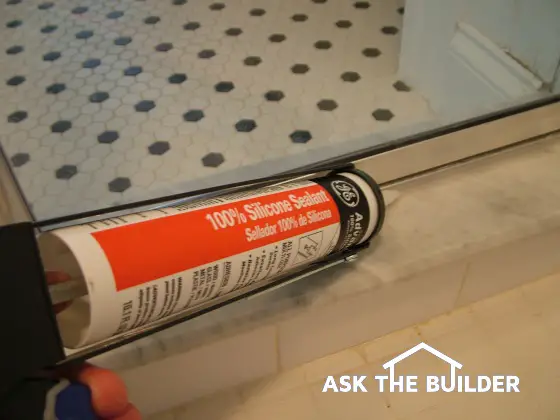Silicone Caulk

Installing silicone caulk can be tricky. Try to squeeze out the exact amount you need. PHOTO CREDIT: Tim Carter
DEAR TIM: Caulking is not my favorite job. I have to use silicone caulk to seal a leaking shower enclosure. Can you offer any tips on caulk removal so I do not damage the metal or the marble curb? What is the secret when working with silicone caulk? I always end up with a mess. Beth S., Sarasota, FL
DEAR BETH: Silicone caulk is a fantastic product, but many will agree with you that it isn't user friendly. Not only can you get really irritated with the mess it creates, but also be very careful if you wear contact lenses. The fumes that are generated as the caulk cures can cause significant eye irritation. Be sure to read the safety label on the caulk tube before you use it.
I recently had to do a nearly identical job in a home I just purchased. The silicone caulk joint between a marble threshold and the aluminum shower enclosure had failed. To make matters worse, the tile setter placed the marble threshold so it had a reverse tilt. Water would pool against the aluminum frame instead of rolling back into the shower. This little bit of hydrostatic pressure caused the water to seep under the aluminum frame and soak the adjoining wall.
Years ago I discovered that to successfully caulk tubs and showers, the joint that is to be caulked needs to be dry. I have a feeling the previous owner knew about this leak as it appeared the joint had been caulked multiple times but with little success. My suspicion is the repairs never worked as the silicone caulk they used was not able to make a good bond. Water was trapped under the aluminum frame and seeped out as the caulk was applied.
I was lucky and was able to use another shower in the house so the leaking one could dry for weeks. If you can't do this, then maybe think about getting ready to do the repair just before you go on vacation or out of town on business. As soon as you get back, install the silicone caulk on a dry joint.
Caulk removal can be tough. I have had great success using an old-fashioned straight-edged razor blade. In my case, I was able to hold the blade at a very low angle slicing between the old silicone caulk and the marble. This didn't cause any scratches. I then cut down through the old caulk with the blade as close to the aluminum frame as possible, but not touching it. The beads of old silicone caulk peeled off the shower like pulling up a strand of spaghetti from a plate. You will probably have the same luck.
I then used some rubbing alcohol to clean the marble and the aluminum frame making sure both surfaces were bone dry and clean. Caulk is really an adhesive, so it works best when surfaces are very clean.
Because I have caulked things for years, I knew how big to cut the tip of the new silicone-caulk tube. This is very important. Make the diameter of the hole no larger than one-sixteenth-inch wide. You do this by cutting the tip of the tube in small passes. It is easy to cut the hole too large.
To get professional results, you must squeeze the caulk from the tube slowly and evenly. A good caulk gun does this with ease. Inexpensive caulk guns will cause you nothing but headaches. A great caulk gun usually costs double or triple what a cheap one costs. It is the best money you will ever spend on a tool.
The secret trick I have used all these years is to apply just enough silicone caulk that when I immediately smooth it with my finger, no excess caulk oozes out around my finger onto the surfaces. Since we all have fingers that come in different sizes, you will need to experiment to determine how much caulk works with your finger.
My advice to you is to make a test corner using two scrap pieces of ceramic tile. Glue them to the inside of a low cardboard box. Start practicing on these mockups until you master the technique. It is not as hard as you might think. I like to caulk a strip about 2-feet long before wiping it with my finger. Be sure to have paper towels on hand to clean up any accidents.
Another secret tip when working with silicone caulk is to wear old clothes and work in a well-ventilated space. The fumes generated by the curing silicone caulk are very strong. If you get silicone caulk on clothing, it is nearly impossible to remove it from the fibers.
You can absolutely get professional results if you take some time and practice. Be sure to take your time applying a smooth bead of silicone caulk, not one that has blobs and voids. When your finger hits a blob of caulk, there is no doubt some will ooze out onto the marble and aluminum creating a massive mess.
Remember that the caulk needs to fully cure before you use your shower again. Don't be fooled thinking the silicone caulk is dry just because it may be tack free within an hour. To fully cure, it needs to react with water vapor in the air. In dry climates, it can take two or three days for your new silicone caulk to fully cure.
Column 742